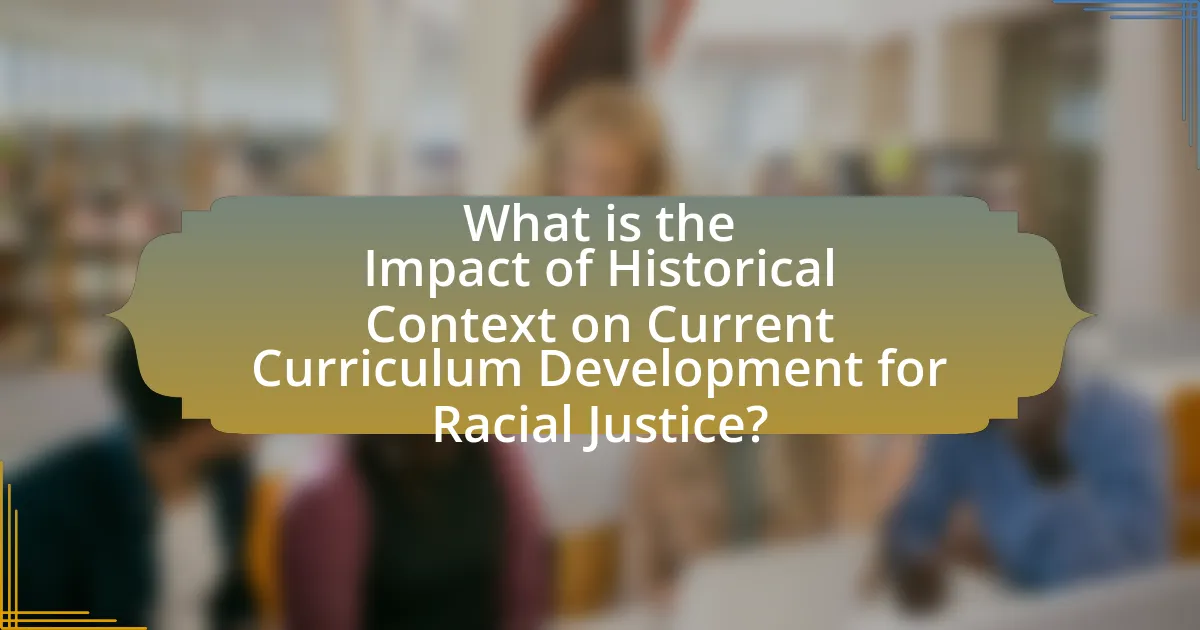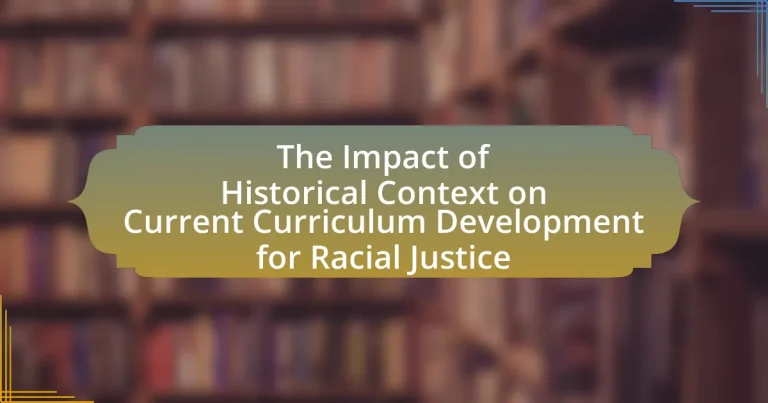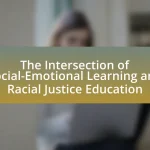The article examines the significant impact of historical context on the development of current curricula aimed at promoting racial justice. It highlights how historical events, such as the Civil Rights Movement and landmark legal decisions like Brown v. Board of Education, shape educational frameworks and content, ensuring the inclusion of diverse perspectives and the acknowledgment of systemic inequalities. The discussion emphasizes the importance of integrating historical narratives into teaching practices to foster critical thinking and empathy among students, while also addressing the challenges and misconceptions that arise in this process. Ultimately, the article underscores the necessity of understanding historical context to create equitable educational environments that reflect the realities of marginalized communities.

What is the Impact of Historical Context on Current Curriculum Development for Racial Justice?
The impact of historical context on current curriculum development for racial justice is significant, as it shapes the frameworks and content that educators use to address systemic inequalities. Historical events, such as the Civil Rights Movement and the legacy of colonialism, inform the narratives included in educational materials, ensuring that they reflect the struggles and achievements of marginalized communities. For instance, the inclusion of African American history in school curricula has been influenced by the push for equitable representation following landmark legislation like the Civil Rights Act of 1964. This historical context not only guides the selection of topics but also influences pedagogical approaches, emphasizing critical thinking and social justice. Consequently, understanding this historical backdrop is essential for developing curricula that promote racial equity and awareness among students.
How has historical context shaped the understanding of racial justice in education?
Historical context has significantly shaped the understanding of racial justice in education by highlighting systemic inequalities and the need for equitable access to resources. The legacy of segregation, particularly through landmark cases like Brown v. Board of Education in 1954, underscored the importance of dismantling discriminatory practices in schools. This case established that separate educational facilities are inherently unequal, prompting reforms aimed at integrating schools and addressing disparities in funding and opportunities. Furthermore, historical movements such as the Civil Rights Movement of the 1960s brought attention to the injustices faced by marginalized communities, influencing educational policies and curricula to include diverse perspectives and promote social justice. These historical events serve as a foundation for current discussions on racial justice in education, emphasizing the necessity of addressing past injustices to create an equitable educational landscape.
What key historical events have influenced curriculum development for racial justice?
Key historical events that have influenced curriculum development for racial justice include the Civil Rights Movement, the Brown v. Board of Education Supreme Court decision, and the establishment of multicultural education initiatives. The Civil Rights Movement, particularly from the 1950s to the 1960s, highlighted systemic racism and led to significant legislative changes, such as the Civil Rights Act of 1964, which mandated equal educational opportunities. The Brown v. Board of Education decision in 1954 declared racial segregation in public schools unconstitutional, prompting a reevaluation of educational curricula to promote inclusivity. Additionally, the rise of multicultural education in the late 20th century aimed to address historical omissions and biases in curricula, advocating for the inclusion of diverse perspectives and histories. These events collectively shaped educational policies and practices aimed at fostering racial justice in schools.
How do historical narratives affect current educational practices regarding racial justice?
Historical narratives significantly shape current educational practices regarding racial justice by influencing curriculum content and pedagogical approaches. These narratives provide context for understanding systemic racism and its historical roots, which educators incorporate into lessons to foster critical thinking and awareness among students. For instance, the inclusion of events such as the Civil Rights Movement and the impact of colonialism in educational materials helps students grasp the complexities of racial issues today. Research indicates that curricula that integrate diverse historical perspectives promote empathy and social responsibility, as evidenced by studies showing improved student engagement and understanding of racial justice when historical context is emphasized.
Why is it important to consider historical context in curriculum development?
Considering historical context in curriculum development is crucial because it informs educators about the societal, cultural, and political factors that have shaped educational practices and content over time. Understanding the historical struggles for racial justice, such as the Civil Rights Movement, allows curriculum developers to create materials that are relevant and sensitive to the experiences of marginalized groups. For instance, incorporating the history of systemic racism and resistance movements can foster a more inclusive educational environment, promoting equity and understanding among students. This approach not only acknowledges past injustices but also empowers students to engage critically with contemporary issues, thereby enhancing their ability to contribute to social change.
What role does historical context play in shaping educational policies?
Historical context significantly influences the formulation of educational policies by reflecting societal values, historical injustices, and demographic changes. For instance, the Civil Rights Movement in the United States led to the implementation of policies aimed at desegregating schools and promoting equal educational opportunities for marginalized groups. This historical backdrop shaped contemporary educational frameworks, emphasizing inclusivity and diversity in curricula. Additionally, historical events such as the Brown v. Board of Education ruling in 1954 established legal precedents that directly impacted educational policy, mandating the end of racial segregation in public schools. Thus, understanding historical context is essential for comprehending the evolution and current direction of educational policies, particularly in the realm of racial justice.
How can understanding historical context improve teaching methods for racial justice?
Understanding historical context enhances teaching methods for racial justice by providing educators with a framework to address systemic inequalities and their origins. By integrating historical events, such as the Civil Rights Movement and the impact of colonialism, educators can illustrate how past injustices shape current societal structures. This approach fosters critical thinking and empathy among students, enabling them to connect historical events to contemporary issues of racial inequality. Research indicates that curricula incorporating historical context lead to deeper student engagement and understanding, as evidenced by studies showing improved academic performance and increased awareness of social justice issues among students exposed to such teaching methods.
What challenges arise when integrating historical context into current curricula?
Integrating historical context into current curricula presents challenges such as resistance from stakeholders, the complexity of historical narratives, and the need for accurate representation. Stakeholders, including educators, parents, and policymakers, may resist changes due to differing beliefs about the relevance of historical context, particularly regarding sensitive topics like racial justice. The complexity of historical narratives can lead to oversimplification or misrepresentation, which undermines educational goals. Furthermore, ensuring accurate representation of diverse perspectives requires extensive research and training for educators, which can be resource-intensive. These challenges highlight the need for careful planning and collaboration in curriculum development to effectively incorporate historical context.
What are the common misconceptions about historical events related to racial justice?
Common misconceptions about historical events related to racial justice include the belief that the Civil Rights Movement was solely a 1960s phenomenon, ignoring earlier efforts by figures like Frederick Douglass and Ida B. Wells. Additionally, many people think that racial justice was achieved with landmark legislation such as the Civil Rights Act of 1964, overlooking ongoing systemic inequalities and resistance. Another misconception is that racial justice issues are primarily a U.S. concern, while similar struggles for equality have occurred globally, such as in South Africa during apartheid. These misconceptions can distort understanding and hinder effective curriculum development for racial justice, as they fail to acknowledge the complexity and continuity of these historical struggles.
How do systemic barriers impact the inclusion of historical context in education?
Systemic barriers significantly hinder the inclusion of historical context in education by perpetuating inequities in curriculum design and access to resources. These barriers, such as socioeconomic disparities, institutional racism, and lack of representation among educators, lead to a narrow portrayal of history that often excludes marginalized perspectives. For instance, research by the National Education Association indicates that predominantly white curricula can reinforce stereotypes and limit students’ understanding of diverse historical narratives. Consequently, students from underrepresented backgrounds may receive an incomplete education that fails to acknowledge their histories, thereby impacting their engagement and sense of belonging in the educational environment.
How can educators effectively incorporate historical context into their curricula?
Educators can effectively incorporate historical context into their curricula by integrating primary sources, such as documents, letters, and artifacts, that reflect the experiences and perspectives of marginalized groups. This approach allows students to engage with history in a meaningful way, fostering critical thinking and empathy. For instance, using the writings of civil rights activists alongside historical events like the Civil Rights Movement provides students with a nuanced understanding of racial justice issues. Research by the National Council for the Social Studies emphasizes that teaching with primary sources enhances students’ analytical skills and deepens their comprehension of historical events, making the learning experience more relevant and impactful.
What strategies can be employed to address historical context in teaching racial justice?
To address historical context in teaching racial justice, educators can employ strategies such as integrating primary source documents, utilizing diverse narratives, and fostering critical discussions. Integrating primary source documents, such as letters, speeches, and legal texts, allows students to engage directly with historical perspectives and understand the complexities of racial issues. Utilizing diverse narratives ensures that multiple viewpoints are represented, highlighting the experiences of marginalized groups throughout history. Fostering critical discussions encourages students to analyze and reflect on historical events and their implications for contemporary society, promoting a deeper understanding of systemic racism and social justice. These strategies are supported by educational research indicating that a comprehensive historical context enhances students’ critical thinking and empathy regarding racial justice issues.
How can educators create inclusive learning environments that reflect historical realities?
Educators can create inclusive learning environments that reflect historical realities by integrating diverse perspectives and narratives into the curriculum. This approach involves incorporating materials that represent various racial, cultural, and historical contexts, ensuring that students learn about the contributions and experiences of marginalized groups. For instance, research by the National Council for the Social Studies emphasizes the importance of teaching history from multiple viewpoints to foster critical thinking and empathy among students. By utilizing primary sources, diverse literature, and inclusive teaching practices, educators can provide a more accurate representation of history that acknowledges systemic injustices and promotes racial justice.
What resources are available for educators to enhance their understanding of historical context?
Educators can enhance their understanding of historical context through various resources, including academic journals, online databases, and educational organizations. For instance, the Journal of American History provides peer-reviewed articles that analyze historical events and their implications, while databases like JSTOR offer access to a wide range of historical documents and scholarly articles. Additionally, organizations such as the National Council for the Social Studies provide curriculum resources and professional development opportunities focused on integrating historical context into teaching practices. These resources are essential for educators aiming to develop a curriculum that addresses racial justice by grounding it in a comprehensive understanding of historical events and their ongoing impact.
What are the best practices for developing a curriculum focused on racial justice?
The best practices for developing a curriculum focused on racial justice include integrating diverse perspectives, fostering critical thinking, and promoting active engagement. Integrating diverse perspectives ensures that the curriculum reflects the histories, experiences, and contributions of marginalized communities, which is essential for a comprehensive understanding of racial justice. Fostering critical thinking encourages students to analyze systemic inequalities and question societal norms, enabling them to engage thoughtfully with the material. Promoting active engagement through discussions, projects, and community involvement allows students to apply their learning in real-world contexts, reinforcing the relevance of racial justice in their lives. Research indicates that curricula incorporating these elements lead to greater awareness and understanding of racial issues among students, ultimately contributing to a more equitable society.
How can collaboration with communities enhance curriculum development for racial justice?
Collaboration with communities enhances curriculum development for racial justice by integrating diverse perspectives and lived experiences into educational content. This approach ensures that the curriculum reflects the realities and histories of marginalized groups, fostering a more inclusive and accurate representation of racial issues. For instance, research conducted by the National Education Association highlights that community involvement in curriculum design leads to increased student engagement and understanding of social justice topics, as it allows for the incorporation of local histories and cultural contexts. By actively involving community members, educators can create a curriculum that not only addresses historical injustices but also empowers students to engage critically with contemporary racial issues.
What assessment methods can be used to evaluate the effectiveness of racial justice curricula?
Assessment methods to evaluate the effectiveness of racial justice curricula include pre- and post-assessments, qualitative interviews, focus groups, and surveys. Pre- and post-assessments measure knowledge and attitudes before and after curriculum implementation, providing quantitative data on learning outcomes. Qualitative interviews and focus groups gather in-depth insights from participants about their experiences and perceptions, revealing the curriculum’s impact on their understanding of racial justice issues. Surveys can quantify changes in attitudes and beliefs among students, offering statistical evidence of the curriculum’s effectiveness. These methods collectively provide a comprehensive evaluation framework that captures both quantitative and qualitative dimensions of learning in racial justice education.
What practical steps can educators take to implement changes in their curriculum for racial justice?
Educators can implement changes in their curriculum for racial justice by integrating diverse perspectives and historical contexts into lesson plans. This involves including materials that reflect the experiences and contributions of marginalized groups, such as African Americans, Indigenous peoples, and other communities of color. Research shows that curricula that incorporate these perspectives can enhance students’ understanding of systemic inequalities and promote critical thinking about social justice issues. For example, the Teaching Tolerance project provides resources that help educators create inclusive curricula that address racial justice, demonstrating the effectiveness of such approaches in fostering an equitable learning environment.


